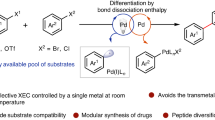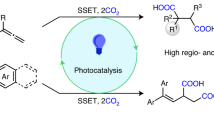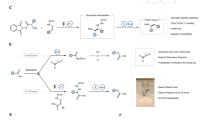Abstract
Reactions that enable carbon–nitrogen, carbon–oxygen and carbon–carbon bond formation lie at the heart of synthetic chemistry. However, substrate prefunctionalization is often needed to effect such transformations without forcing reaction conditions. The development of direct coupling methods for abundant feedstock chemicals is therefore highly desirable for the rapid construction of complex molecular scaffolds. Here we report a copper-mediated, net-oxidative decarboxylative coupling of carboxylic acids with diverse nucleophiles under visible-light irradiation. Preliminary mechanistic studies suggest that the relevant chromophore in this reaction is a Cu(ii) carboxylate species assembled in situ. We propose that visible-light excitation to a ligand-to-metal charge transfer (LMCT) state results in a radical decarboxylation process that initiates the oxidative cross-coupling. The reaction is applicable to a wide variety of coupling partners, including complex drug molecules, suggesting that this strategy for cross-nucleophile coupling would facilitate rapid compound library synthesis for the discovery of new pharmaceutical agents.

This is a preview of subscription content, access via your institution
Access options
Access Nature and 54 other Nature Portfolio journals
Get Nature+, our best-value online-access subscription
$29.99 / 30 days
cancel any time
Subscribe to this journal
Receive 12 print issues and online access
$259.00 per year
only $21.58 per issue
Buy this article
- Purchase on Springer Link
- Instant access to full article PDF
Prices may be subject to local taxes which are calculated during checkout


Similar content being viewed by others
Data availability
All data supporting the findings of this study are available within the paper and its Supplementary Information.
References
Xuan, J., Zhang, Z.-G. & Xiao, W.-J. Visible-light-induced decarboxylative functionalization of carboxylic acids and their derivatives. Angew. Chem. Int. Ed. 54, 15632–15641 (2015).
Rodríguez, N. & Goossen, L. J. Decarboxylative coupling reactions: a modern strategy for C–C-bond formation. Chem. Soc. Rev. 40, 5030–5048 (2011).
Arshadi, S., Ebrahimiasl, S., Hosseinian, A., Monfared, A. & Vessally, E. Recent developments in decarboxylative cross-coupling reactions between carboxylic acids and N–H compounds. RSC Adv. 9, 8964–8976 (2019).
Zeng, Z., Feceu, A., Sivendran, N. & Gooßen, L. J. Decarboxylation‐initiated intermolecular carbon–heteroatom bond formation. Adv. Synth. Catal. 363, 2678–2722 (2021).
Scott, E., Peter, F. & Sanders, J. Biomass in the manufacture of industrial products—the use of proteins and amino acids. Appl. Microbiol. Biotechnol. 75, 751–762 (2007).
Gallezot, P. Conversion of biomass to selected chemical products. Chem. Soc. Rev. 41, 1538–1558 (2012).
Patra, T. & Maiti, D. Decarboxylation as the key step in C–C bond-forming reactions. Chem. Eur. J. 23, 7382–7401 (2017).
Gooßen, L. J., Deng, G. & Levy, L. M. Synthesis of biaryls via catalytic decarboxylative coupling. Science 313, 662–664 (2006).
Moon, P. J. & Lundgren, R. J. Metal-catalyzed ionic decarboxylative cross-coupling reactions of C(sp3) acids: reaction development, mechanisms and application. ACS Catal. 10, 1742–1753 (2010).
Zuo, Z. & MacMillan, D. W. C. Decarboxylative arylation of α‑amino acids via photoredox catalysis: a one-step conversion of biomass to drug pharmacophore. J. Am. Chem. Soc. 136, 5257–5260 (2014).
Zuo, Z. et al. Enantioselective decarboxylative arylation of α‑amino acids via the merger of photoredox and nickel catalysis. J. Am. Chem. Soc. 138, 1832–1835 (2016).
Shibutani, S. et al. Organophotoredox-catalyzed decarboxylative C(sp3)−O bond formation. J. Am. Chem. Soc. 142, 1211–1216 (2020).
Mao, R., Frey, A., Balon, J. & Hu, X. Decarboxylative C(sp3)–N cross-coupling via synergetic photoredox and copper catalysis. Nat. Catal. 1, 120–126 (2018).
Kolbe, H. Beobachtungen über die oxydirende Wirkung des Sauerstoffs, wenn derselbe mit Hülfe einer elektrischen Säule entwickelt wird. J. Prakt. Chem. 41, 137–139 (1847).
Hofer, H. & Moest, M. Ueber die Bildung von Alkoholen bei der Elektrolyse fettsaurer Salze. Justus Liebigs Ann. Chem. 323, 284–323 (1902).
Xiang, J. et al. Hindered dialkyl ether synthesis with electrogenerated carbocations. Nature 573, 398–402 (2019).
Eberson, L. & Nyberg, K. Studies on the Kolbe electrolytic synthesis. V. An electrochemical analogue of the Ritter reaction. Acta Chem. Scand. 18, 1567–1568 (1964).
Kochi, J. K. A new method for halodecarboxylation of acids using lead(IV) acetate. J. Am. Chem. Soc. 87, 2500–2502 (1965).
Bacha, J. & Kochi, J. K. Alkenes from acids by oxidative decarboxylation. Tetrahedron 24, 2215–2226 (1968).
Wang, Z. in Comprehensive Organic Name Reactions and Reagents (ed. Wang, Z.) 1646–1649 (Wiley, 2010).
Agterberg, F. P. W., Driessen, W. L., Reedijk, J., Oeveringb, H. & Buijs, W. Copper-catalyzed oxidative decarboxylation of aliphatic carboxylic acids. Stud. Surf. Sci. Catal. 82, 639–646 (1994).
Serguchev, Y. A. & Beletskaya, I. P. Oxidative decarboxylation of carboxylic acids. Usp. Khim. 49, 2257–2285 (1980).
Kong, D., Moon, P. J., Bsharat, O. & Lundgren, R. L. Direct catalytic decarboxylative amination of aryl acetic acids. Angew. Chem. Int. Ed. 59, 1313–1319 (2020).
Liang, Y., Zhang, X. & MacMillan, D. W. C. Decarboxylative sp3 C–N coupling via dual copper and photoredox catalysis. Nature 559, 83–88 (2018).
Sakakibara, Y., Ito, E., Fukushima, T., Murakami, K. & Itami, K. Late‐stage functionalization of arylacetic acids by photoredox‐catalyzed decarboxylative carbon–heteroatom bond formation. Chem. Eur. J. 24, 9254–9258 (2018).
Drapeau, M. P., Bahri, J., Lichte, D. & Gooßen, L. J. Decarboxylative ipso amination of activated benzoic acids. Angew. Chem. Int. Ed. 58, 892–896 (2019).
Nguyen, V. T. et al. Visible light‐enabled direct decarboxylative N‐alkylation. Angew. Chem. Int. Ed. 59, 7921–7927 (2020).
Reed, N. L. & Yoon, T. P. Oxidase reactions in photoredox catalysis. Chem. Soc. Rev. 50, 2954–2967 (2021).
Reed, N. L., Herman, M. I., Miltchev, V. P. & Yoon, T. P. Photocatalytic oxyamination of alkenes: copper(II) salts as terminal oxidants in photoredox catalysis. Org. Lett. 20, 7345–7350 (2018).
Reed, N. L., Herman, M. I., Miltchev, V. P. & Yoon, T. P. Tandem copper and photoredox catalysis in photocatalytic alkene difunctionalization reactions. Beilstein J. Org. Chem. 15, 351–356 (2019).
Lee, B. J., DeGlopper, K. S. & Yoon, T. P. Site-selective alkoxylation of benzylic C–H bonds via photoredox catalysis. Angew. Chem. Int. Ed. 59, 197–202 (2020).
Reed, N. L., Lutovsky, G. A. & Yoon, T. P. Copper-mediated radical-polar crossover enables photocatalytic oxidative functionalization of sterically bulky alkenes. J. Am. Chem. Soc. 143, 6065–6070 (2021).
Guideline for Elemental Impurities Q3D, Current Step 4 version (European Medicines Agency, 2014).
Morimoto, J. Y. & DeGraff, B. A. Photochemistry of copper complexes. The copper(ll) malonate system. J. Phys. Chem. 79, 326–331 (1975).
Sun, L., Wu, C.-H. & Faust, B. C. Photochemical redox reactions of inner-sphere copper(II)-dicarboxylate complexes: effects of the dicarboxylate ligand structure on copper(I) quantum yields. J. Phys. Chem. A 102, 8664–8672 (1998).
Sun, L., Wu, C.-H. & Faust, B. C. Photochemical formation of copper(I) from copper(II)-dicarboxylate complexes: effects of outer-sphere versus inner-sphere coordination and of quenching by malonate. J. Phys. Chem. A 104, 4989–4996 (2000).
Xu, P., López–Rojas, P. & Ritter, T. Radical decarboxylation carbometalation of benzoic acids: a solution to aromatic decarboxylative fluorination. J. Am. Chem. Soc. 143, 5349–5354 (2021).
Zhao, C., Rakesh, K. P., Ravidar, L., Fang, W.-Y. & Qin, H.-L. Pharmaceutical and medicinal significance of sulfur (SVI)-containing motifs for drug discovery: a critical review. Eur. J. Med. Chem. 162, 679–734 (2019).
Tsybizova, A. et al. Speciation behavior of copper(II) acetate in simple organic solvents-revealing the effect of trace water. Eur. J. Inorg. Chem. 2014, 1407–1412 (2014).
Kochi, J. K., Bemis, A. & Jenkins, C. L. Mechanism of electron transfer oxidation of alkyl radicals by copper(II) complexes. J. Am. Chem. Soc. 90, 4616–4625 (1968).
Dendrinou-Samara, C. et al. Copper(II) complexes with anti-inflammatory drugs as ligands. Solution behaviour and electrochemistry of mono- and bi-nuclear complexes. J. Chem. Soc. Dalton Trans. 1992, 3259–3264 (1992).
Graddon, D. P. The absorption spectra of complex salts—IV cupric alkanoates. J. Inorg. Nucl. Chem. 17, 222–231 (1961).
Kyuzou, M., Mori, W. & Tanaka, J. Electronic structure and spectra of cupric acetate mono-hydrate revisited. Inorg. Chim. Acta 363, 930–934 (2010).
Acknowledgements
We thank W. B. Swords for helpful discussions. Funding for this work was provided by the NIH (R01GM095666, T.P.Y.), an ACS GCI Pharmaceutical Roundtable Research Grant (T.P.Y.) and Pfizer (T.P.Y.). S.N.G. thanks the NIH for a fellowship grant (F32GM139373) and G.A.L. is the recipient of a 3M Science & Technology Fellowship. Analytical facilities at UW–Madison are funded by the NIH (S10OD012245), NSF (CHE-9304546) and a generous gift from the Paul J. and Margaret M. Bender Fund.
Author information
Authors and Affiliations
Contributions
Q.Y.L., S.N.G., G.A.L., K.S.D. and T.P.Y. conceived the project. Experimental work was conducted by Q.Y.L., S.N.G., N.J.B., M.W.B. and J.W.T. S.W.B. and T.P.Y. supervised the research. All authors contributed to the writing and editing of the manuscript.
Corresponding author
Ethics declarations
Competing interests
N.J.B., M.W.B., J.W.T. and S.W.B. are employees and shareholders of Pfizer, Inc. The remaining authors declare no competing interests.
Additional information
Peer review information Nature Chemistry thanks the anonymous reviewers for their contribution to the peer review of this work.
Publisher’s note Springer Nature remains neutral with regard to jurisdictional claims in published maps and institutional affiliations.
Supplementary information
Supplementary Information
General information, select optimization results, substrate preparation, isolation and characterization, additional mechanistic studies, references, spectral data, Tables 1–25 and Figs. 1–10.
Supplementary Data 1
An excel spreadsheet containing the raw data obtained from the UV–vis spectrometer for the carboxylate titration study. A brief walkthrough of the data processing to obtain the final, published plot is included.
Rights and permissions
About this article
Cite this article
Li, Q.Y., Gockel, S.N., Lutovsky, G.A. et al. Decarboxylative cross-nucleophile coupling via ligand-to-metal charge transfer photoexcitation of Cu(ii) carboxylates. Nat. Chem. 14, 94–99 (2022). https://doi.org/10.1038/s41557-021-00834-8
Received:
Accepted:
Published:
Issue Date:
DOI: https://doi.org/10.1038/s41557-021-00834-8
This article is cited by
-
Photocatalytic hydrofluoroalkylation of alkenes with carboxylic acids
Nature Chemistry (2023)
-
Bifunctionality of dirhodium tetracarboxylates in metallaphotocatalysis
Nature Communications (2023)



